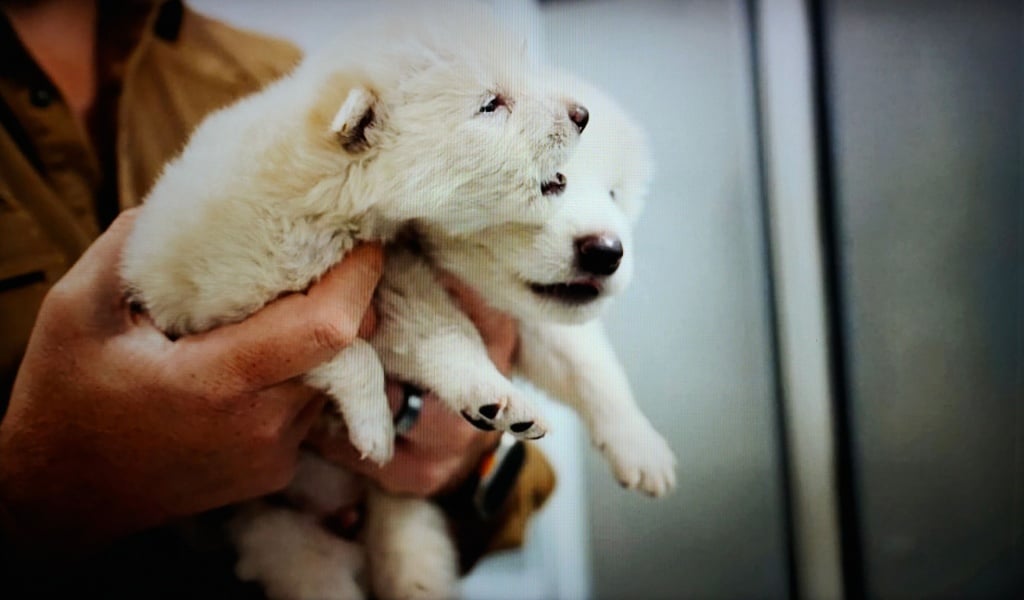Picture walking through a forest, hearing a loud, echoing howl, and then spotting an animal from the Ice Age. It feels like a dream, right?
The dire wolf, an extinct predator that disappeared over 10,000 years ago, is making a comeback. Well, kind of.
Thanks to a combination of advanced genetic science and a pop culture obsession, Colossal Biosciences has generated animals that resemble the dire wolf in both appearance and behavior. And strangely, we have the hit TV show, “Game of Thrones,” to thank for the drive behind this incredible comeback story.

Dire Wolves and the Pop Culture Influence
If you’ve watched the HBO hit “Game of Thrones,” you may remember the dire wolves—loyal, magnificent, and almost magical creatures connected to the Stark family. Fans immediately fell in love with these wolves. However, those fictional creatures didn’t just entertain; they inspired. According to Colossal Biosciences, the show played a key role in increasing public interest in reviving the real dire wolf.
This enthusiasm led to funding and research. The story exploded across headlines when Colossal announced plans to “de-extinct” the dire wolf. Even Time ran a cover story about a white “dire wolf pup,” combining science and fantasy into a single viral moment.
Are These Dire Wolves Real?
This is where things get complex. These pups are still 99.5% genetically gray wolves. The edits only made them look like dire wolves. Scientists refer to them as “proxies,” not actual dire wolves.
So, while they resemble these dire wolves, they aren’t the exact recreations of the extinct species. Instead, they resemble advanced cosplay: modern wolves cloaked in the genes of the Ice Age.
The Purpose of Bringing Them Back
Colossal’s objective goes beyond science. The company believes these techniques will help preserve rare species, such as the red wolf. They’ve already utilized this technology to enhance red wolf genetics in captivity, where fewer than 300 are left.
How Science & Fiction Together Created the Dire Wolf 2.0
Here’s how Colossal executed this ancient reboot:
- DNA Discovery: Scientists were able to piece together parts of the dire wolf’s DNA using fossils that contained a 13,000-year-old tooth and a 72,000-year-old ear bone.
- CRISPR Magic: Scientists identified essential genes responsible for the dire wolf’s appearance (bigger build, broad skull, white fur) and altered these into the genetic code of a contemporary gray wolf.
- Wolf + Dog = Pup: To prevent intrusive methods on wild wolves, they used eggs of domestic dogs and surrogates to carry the embryos.
- The Birth of the Wolves: In late 2024 and early 2025, three puppies were born: Romulus, Remus, and Khaleesi. Although they appear the same with their snowy coats and strong frames, their genetics reveal a more complex story.
Dire Wolves to Woolly Mammoths
Colossal has big plans. In addition to the dire wolf, the company is working on reviving the woolly mammoth, the dodo, the Tasmanian tiger, and the passenger pigeon. In one impressive experiment, they created “woolly mice” (normal mice with mammoth-like fur) as a minor but brilliant move toward their mammoth objectives.
Every project aims to test the limits of gene editing. However, the real test isn’t in the lab; it’s determining whether there’s still a place for these animals in the modern world.
The Debate Over Conservation
Conservationists are concerned that flashy de-extinction initiatives may divert attention from pressing environmental needs. Poaching, climate change, and habitat destruction won’t be solved by bringing back species or species clones.
Another concern is that the government could misuse the idea. “We can just bring them back later,” some U.S. representatives have already argued against protections for endangered species. This mindset could result in reckless decisions and weakened environmental regulations.
Then there’s also a question: what happens if a large predator is reintroduced into an ecosystem that’s no longer suitable for it?

The GOT Effect: Beyond Fiction
The “Game of Thrones” effect cannot be underestimated. George R.R. Martin, the author behind the saga, even visited Colossal’s lab. He allegedly cried while holding a white pup, claiming that the moment moved him more than any scientific discovery since the moon landing.
That emotional pull is essential. People contribute, support, and promote causes they feel connected to, and GOT created a fan following for Dire Wolves.
However, emotion alone is not sufficient. This type of science requires careful planning, ethical strategies, and ecological knowledge to make sure it does more good than harm.
A Sneak Peek at the Future
So, what does all this mean? Are we truly entering an era where extinction is a matter of choice? Not really. These animals, reminiscent of dire wolves, are remarkable scientific achievements, but they are not exact replicas of their ancestors. Instead, they resemble carefully selected tributes to extinct creatures. Nevertheless, this creation opens a door—an opportunity for better conservation tools, advances in gene editing, and perhaps someday, the revival of something long gone.
Meanwhile, Romulus, Remus, and Khaleesi stand as icons not only of what science has accomplished but also of how culture, sentiments, and interest can shape the future of life on Earth.
So, if you ever hear that low, ancient howl, remember: it’s not just a sound from the past but a sign of what’s ahead.



